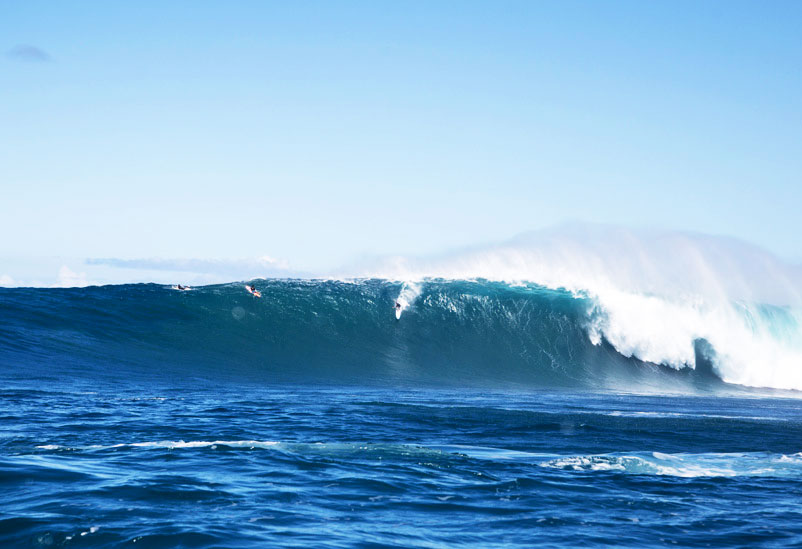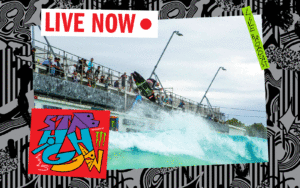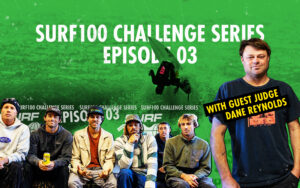Know this if you’re gonna surf Peahi: Grant ‘Twiggy’ Baker’s Guide To Jaws
First of all, if you’re one of the 99.8 percent majority of the world’s surfing population, you should not be surfing Jaws. Even if you’re in that point-two percent, it might mean you could be out there, but whether or not you should is still another matter. This is not everyone. It’s for very, very few. Regardless, this is good reading. Great reading, in fact, like a crime thriller you’ll never completely relate to but still allow to raise your hairs. Grant ‘Twiggy’ Baker, a wildly articulate South African gent who likes hyper-intense situations way more than you, paints us a word picture of what it’s really like to be in the mix at Hawaii’s most famous (ultra) big wave spot… Interview by Dooma Fahrenfort Best Jaws board: Well, this last swell I used an experimental 10’0” that had the volume of and 11’0” – we widened it up and thickened it up, and that worked pretty well. But generally you’d wanna paddle out for your first time on a 10’6”x 21’3/4”x 2’3/4”. They’d probably be the perfect measurements. Navigating the crowd: Same as anywhere, really, but in Hawaii you just need to take your time, don’t ever be agressive, don’t ever paddle on people’s inside, and just be patient and hope that a wave eventually comes to you. Generally on the big days, and this is anywhere in the world, if you are patient, eventually a wave will pick you out where no one else is in the position and you’re the only one that has a chance to catch it. That’s the general rule in Hawaii; Wait for the wave to pick you out. Don’t go around trying to hunt it down – that’s how you’ll get into trouble. Navigating the rock jump: Geez. The rock jump is probably the worst part about surfing Jaws. It’s even more scary than the waves themselves. Jumping out is not as bad as coming in – but I mean, it’s still seriously nerve-wracking ‘cause if you mistime it, you can get into a very bad situation. But coming in its worse, because you can’t see the sets coming, you can’t time it on the lulls ‘cause it’s just constant waves bashing on the boulders. Fuck, every time I’ve done it I’ve lost a fin or dinged up a board or scraped myself. So, I don’t know if I’m the best guy to ask. It’s an absolute nightmare. It’s Waimea shorebreak onto boulders, and you’ve gotta time going in and out. Holding a big board and balancing on rocks. We don’t put our fins in, we put them in our wetsuits and then only once you’re though the shorebreak do you put your fins in. Nine times out of 10 you’re knocking a fin out otherwise. And then before you come in you try and take them out, then come in. You don’t want to knock a fin box out mostly, ‘cause then you’ve got nothing to surf on that afternoon or the next day. Photo: Marc Chambers Paddling into a wave: Even though it’s quite close to shore, Jaws feels like a big, open ocean outer reef. So, you wanna be catching it early – you don’t wanna be swinging under the lip and late-dropping into it, because by then generally the wave is moving so fast that it’ll steam roll you and you won’t make the channel. What you wanna do is get in early, set a line aiming towards the west bowl as you take off, and hold that line throughout the wave. That’s pretty much the only way you can make it – get in early, get to the bottom early, and get that line towards the channel early. Wiping out: Look, Jaws is very focused. The energy tends to focus on one point. So the initial hit when you wipeout or straighten out is extremely violent. But then after that, because it’s so focused, it dissipates really quickly. Well, I mean, reasonably quickly. It’s not like places like Belharra or Cortez, where it starts off slopey and really gains momentum, where it holds you down for a long time and drags you under water for a long time. At Jaws, the initial impact is as violent as you get. kinda similar to Mavericks. It can hold you down forever, but it doesn’t have that steam roller effect. There’s positives and negatives with all the big waves, but if you take a lip at Jaws it’s the most violent 10 seconds you’ll ever experience in a wipeout. Do’s and Don’ts: Be super patient! Pick the right waves. Take off on waves that you aren’t guaranteed to make, because the consequences are so severe, the violence, the hold down, nine times out of 10 your leash comes off your ankle or snaps, or you break your board, then you’ve gotta get another board and get back out there, or you lose all your energy… after one bad wipeout at Jaws, your day is kind of over. For me, it’s all about being super patient and catching only waves that you have a super high chance of making.
First of all, if you’re one of the 99.8 percent majority of the world’s surfing population, you should not be surfing Jaws. Even if you’re in that point-two percent, it might mean you could be out there, but whether or not you should is still another matter. This is not everyone. It’s for very, very few. Regardless, this is good reading. Great reading, in fact, like a crime thriller you’ll never completely relate to but still allow to raise your hairs. Grant ‘Twiggy’ Baker, a wildly articulate South African gent who likes hyper-intense situations way more than you, paints us a word picture of what it’s really like to be in the mix at Hawaii’s most famous (ultra) big wave spot…
Interview by Dooma Fahrenfort
Best Jaws board: Well, this last swell I used an experimental 10’0” that had the volume of and 11’0” – we widened it up and thickened it up, and that worked pretty well. But generally you’d wanna paddle out for your first time on a 10’6”x 21’3/4”x 2’3/4”. They’d probably be the perfect measurements.
Navigating the crowd: Same as anywhere, really, but in Hawaii you just need to take your time, don’t ever be agressive, don’t ever paddle on people’s inside, and just be patient and hope that a wave eventually comes to you. Generally on the big days, and this is anywhere in the world, if you are patient, eventually a wave will pick you out where no one else is in the position and you’re the only one that has a chance to catch it. That’s the general rule in Hawaii; Wait for the wave to pick you out. Don’t go around trying to hunt it down – that’s how you’ll get into trouble.
Navigating the rock jump: Geez. The rock jump is probably the worst part about surfing Jaws. It’s even more scary than the waves themselves. Jumping out is not as bad as coming in – but I mean, it’s still seriously nerve-wracking ‘cause if you mistime it, you can get into a very bad situation. But coming in its worse, because you can’t see the sets coming, you can’t time it on the lulls ‘cause it’s just constant waves bashing on the boulders. Fuck, every time I’ve done it I’ve lost a fin or dinged up a board or scraped myself. So, I don’t know if I’m the best guy to ask. It’s an absolute nightmare. It’s Waimea shorebreak onto boulders, and you’ve gotta time going in and out. Holding a big board and balancing on rocks. We don’t put our fins in, we put them in our wetsuits and then only once you’re though the shorebreak do you put your fins in. Nine times out of 10 you’re knocking a fin out otherwise. And then before you come in you try and take them out, then come in. You don’t want to knock a fin box out mostly, ‘cause then you’ve got nothing to surf on that afternoon or the next day.

Photo: Marc Chambers
Paddling into a wave: Even though it’s quite close to shore, Jaws feels like a big, open ocean outer reef. So, you wanna be catching it early – you don’t wanna be swinging under the lip and late-dropping into it, because by then generally the wave is moving so fast that it’ll steam roll you and you won’t make the channel. What you wanna do is get in early, set a line aiming towards the west bowl as you take off, and hold that line throughout the wave. That’s pretty much the only way you can make it – get in early, get to the bottom early, and get that line towards the channel early.
Wiping out: Look, Jaws is very focused. The energy tends to focus on one point. So the initial hit when you wipeout or straighten out is extremely violent. But then after that, because it’s so focused, it dissipates really quickly. Well, I mean, reasonably quickly. It’s not like places like Belharra or Cortez, where it starts off slopey and really gains momentum, where it holds you down for a long time and drags you under water for a long time. At Jaws, the initial impact is as violent as you get. kinda similar to Mavericks. It can hold you down forever, but it doesn’t have that steam roller effect. There’s positives and negatives with all the big waves, but if you take a lip at Jaws it’s the most violent 10 seconds you’ll ever experience in a wipeout.
Do’s and Don’ts: Be super patient! Pick the right waves. Take off on waves that you aren’t guaranteed to make, because the consequences are so severe, the violence, the hold down, nine times out of 10 your leash comes off your ankle or snaps, or you break your board, then you’ve gotta get another board and get back out there, or you lose all your energy… after one bad wipeout at Jaws, your day is kind of over. For me, it’s all about being super patient and catching only waves that you have a super high chance of making.













Comments
Comments are a Stab Premium feature. Gotta join to talk shop.
Already a member? Sign In
Want to join? Sign Up